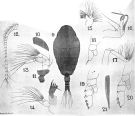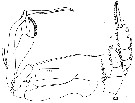|
|
 |
|
Calanoida ( Order ) |
|
|
|
Clausocalanoidea ( Superfamily ) |
|
|
|
Aetideidae ( Family ) |
|
|
|
Chiridiella ( Genus ) |
|
|
| |
Chiridiella ovata Deevey, 1974 (F) | |
| | | | | | | Syn.: | ? Chiridiella macrodactyla : A. Scott, 1909 (p.79, 196, figs.F, Rem.) | | | | Ref.: | | | Deevey, 1974 (p.456, Descr.F, figs.F); Roe, 1975 (p.306, figs.F); Markhaseva, 1996 (p.99, figs.F); Vives & Shmeleva, 2007 (p.557, Rem.F) |  issued from : A. Scott in Siboga-Expedition, 1909, XIX a. [Plate XXXVI, Figs.9-21]. As Chiridiella macrodactyla. With doubt. Female (from Halmahera Sea): 9, habitus (dorsal); 10, forehead (lateral); 11, last thoracic and genital segments (left side); 12, A1; 13, A2; 14, Md; 15, Mx1; 16, Mx2; 17, Mxp; 18, P1; 19, P2; 20, P4; 21, terminal spine (exopodite of P4).
|
 issued from : G.B. Deevey in Bull. Mar. Sc., 1974, 24 (2). [p.457, Fig.10]. Female (from 32°10'N, 64°30'W): a-b, habitus (dorsal and lateral, respectively); c, A2; d, Md (masticatory edge); e, Md (mandibular palp); f, Mx1; g, P1; h, P2; i, P4; j, Mxp (endopod setae not shown). Scale at left margin for parts a and b; at lower right for parts c-j. Scales in mm. Nota : Head and 1st thoracic segment separate. Cephalothorax about 80 % of total body length. Urosome 25 % cephalothorax length. A1 23-segmented. Endopod of A2 about 2/3 length of exopod. Mx2 of macrodactyla type, very similar to that of C. macrodactyla A. Scott (1909), with 5 lobes (Mx2 figured by Scott lacks the small 2nd lobe and has longer setae on lobe 5, but is otherwise identical).
|
 issued from : G.A. Deevey in Bull. Mar. Sc., 1974, 24 (2). [p.459, Fig.11, e-f]. Female: e, P3; f, Mx2. Scales in mm.
|
 issued from : H.S.J. Roe in Bull. British Mus. (Natural History) Zool., London, 1975, 28 (7). [p.307, Fig.6]. Female (Cape Verde Islands): a, habitus (dorsal); b, idem (left lateral side); c, A2; d, mandibular palp; e, masticatory edge of Md; f, Mx1 (left); g, Mx1 (right); h, Mx2; i, Mxp; j, P1; k, P2; l, P4. Bar scale 0.1 mm unless indicated. Nota: Mx1 is variable: On the left side (Fig.6f) the 3rd inner lobe is absent, contrasting with Deevey's specimens, and the exopodite has 3 setae; on the right (Fig.6g) the 3rd inner lobe is present and has 1 seta, but the exopodite has only two. Mx1 of Scott's (1909) specimen differs from both this and Deevey's account. The 2nd lobe of Mx2 is very small in the present specimen, and the seta on the 1st basipodite of Mxp is present on one side only. The endopodites of P3 and P4 have only 1 segment but the lines of fusion are clearly visible.
|
 Chiridiella ovata Chiridiella ovata female: 1 - Mx2 with 5 endites. 2 - Mx2 strongly modified in comparison with typical; first-fifth endites of varying size; Setation is not typical, some number of setae on third-fifth endites transformed into pincers-like spines. 3 - Setae of fourth endite of Mx2 arranged like pincers. 4 - Endopodal segment 2 of Md with 4 setae. Mx1 with exopod, exopod with 3 setae. 5 - Protopodite of Mxp with 1 seta in distal group.
|
 Chiridiella ovata Chiridiella ovata female ; 1 - Penultimate lobe of Mx2 with 1 long and 1 short spine arranged as pincers. 2 - Mx2 with 4 or 5 lobes. 3 - A1 not extending beyond genital segment. 4 - Proximal lobe of Mx2 with 1 long seta.
| | | | | Compl. Ref.: | | | Deevey & Brooks, 1977 (p.256, tab.2, Station 'S"); Vives, 1982 (p.291) | | | | NZ: | 2 + 1 doubtful | | |
|
Distribution map of Chiridiella ovata by geographical zones
|
| | | | Loc: | | | off Bermuda: Station "S" (32°10'N, 64°30'W), Cape Verde Is., off Mauritania, Morocco-Mauritania, ? Indonesia-Malaysia (Halmahera Sea).
Type locality: 32°10'N, 64°30'W. | | | | N: | 4 | | | | Lg.: | | | ? (5) F: 2,73; (224) F: 2,35; {F: 2,35} | | | | Rem.: | meso-bathypelagic. Sargasso Sea: 500-1500 m (Deevey & Brooks, 1977 , station "S");
For A. Scott (1909, p.79) there is no other difference between the 'Siboga' form and Sars' description, than that the combined length of the urosome is very slightly less than one-third of the total length of the cephalothorax, from the frontal margin to the base of the genital segment. The specimens from the deep water off the West Coast of Ireland appear to be almost identical with the 'Siboga' form.
For Deevey (1974, p.458), except for the reduced segmentation of the exopods of P3 and P4, which may be subject to individual interpretation when signs of segmentation are present, this species closely resembles C. macrodactyla Scott from the Halmahera Sea. | | | Last update : 26/07/2018 | |
|
|
 Any use of this site for a publication will be mentioned with the following reference : Any use of this site for a publication will be mentioned with the following reference :
Razouls C., Desreumaux N., Kouwenberg J. and de Bovée F., 2005-2025. - Biodiversity of Marine Planktonic Copepods (morphology, geographical distribution and biological data). Sorbonne University, CNRS. Available at http://copepodes.obs-banyuls.fr/en [Accessed August 27, 2025] © copyright 2005-2025 Sorbonne University, CNRS
|
|
 |
 |







